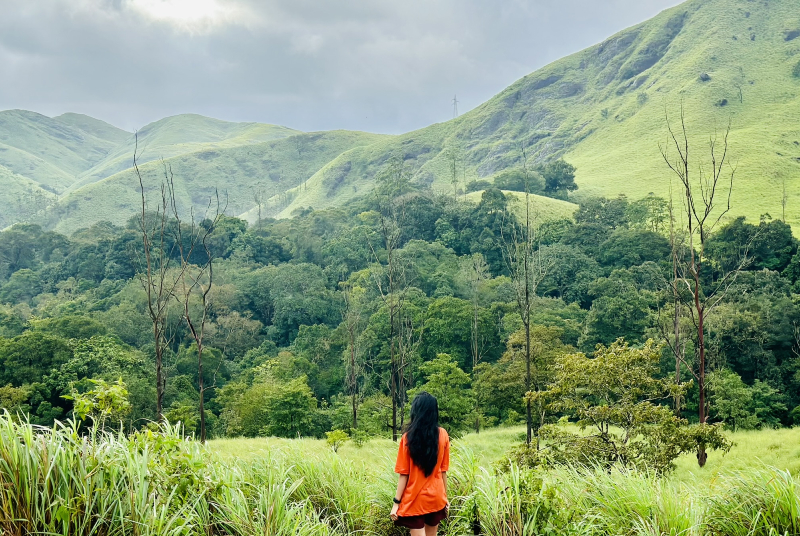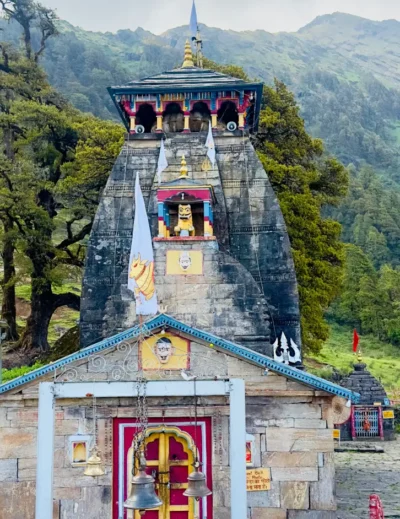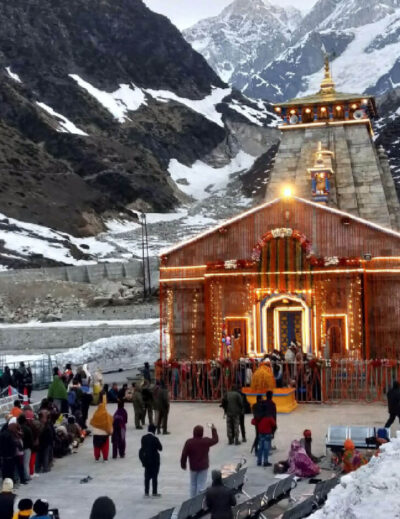
Rudranath Trek Guide: Panch Kedar’s Most Mystical & Remote Shiva Temple
If Madhyamaheshwar was a silent whisper of devotion, Rudranath was a loud roar — wild, raw, and deeply humbling. Known as the second Kedar in the Panch Kedar Yatra, Rudranath is revered as the place where Lord Shiva’s face (mukh) appeared in his fierce form — the Raudra roop.
This blog is for every traveler who seeks solitude, soul-stirring beauty, and a challenge wrapped in thick forests, Bugyals, and unpredictable skies.
Quick Info
| Detail | Info |
|---|---|
| Starting Point | Sagar Village (Near Gopeshwar, Uttarakhand) |
| Trek Distance | ~20–22 km one way |
| Duration | 3 days (Sagar → Lyuti Bugyal → Rudranath → Return) |
| Difficulty | Moderate (Tiring due to continuous ascents) |
| Stay Options | Limited. Basic tents at Lyuti Bugyal & Rudranath |
| Best Season | May to October |
| Temple Altitude | ~3600 m |
| Not Allowed | Mules. Carry your own backpack |
| Highlights | Lyuti Bugyal, Pitra Dhar, Sandhya Aarti, Valley Views, Shiva Temple |
Pro Tip:
Don’t rush Rudranath — keep 3 to 4 days aside if possible to really soak in the peace and energy.
The Trail Begins: Sagar to Lyuti Bugyal
We began our journey from Sagar village, a quiet little hamlet near Gopeshwar. Within the first 30 minutes of the trail, we reached the forest department check-post, where everyone must register with a nominal fee.
The route to Lyuti Bugyal is entirely uphill, and the trail tests your patience. But every step forward is a moment closer to peace. We crossed thick green forests, rain-soaked trails, and steep ridges. Expect 6–7 hours of trekking, especially if you’re carrying your own backpack.
I remember sudden rain showers on the way — sometimes mild, sometimes pouring heavily. Carrying a good rain jacket, trekking shoes, and rain cover for backpack is a must here.
There were very few dhabas on the way (expect 2 small eating places), so pack some basic dry fruits and say no to plastic-packed snacks. I chose Buransh juice to energize myself — a local delight you must try!
Note:
- Don’t attempt to cross Lyuti Bugyal after 2 PM as there’s no stay option beyond until the temple.
- Night stay at Lyuti Bugyal is around ₹1000 including dinner (as of 2025).
- It’s just tents, no luxury — but the peace and vibe are unmatched.
Planning your full Panch Kedar Yatra?
Lyuti to Rudranath Temple: Through Pitra Dhar and the Valley of Silence
Early morning, I left Lyuti Bugyal after a hearty breakfast. The trail moves steadily towards Pitra Dhar, a spiritual point considered to be a symbolic passage where ancestors are remembered.
From here, the trek is a mix of ascends and descends, often with mist covering the valleys, revealing only flashes of deep greens and endless ridges.
No mules. No shortcuts. No distractions. Just you, your will, and the wild spirit of Rudranath guiding your path.
After another 6–7 hours of trekking, I reached Rudranath temple. The limited tents here are managed well, but again — it’s about bare essentials, not comfort. Food, tea, basic bedding — that’s it.
Reaching Rudranath Temple: The Fierce and the Benevolent
When I finally reached the temple, I met many pilgrims, solo trekkers, and old villagers with stories of faith and fire. We motivated each other, shared raincoats, and sang Bhajans — the trail makes you emotional in the most unexpected way.
The darshan of Shiva’s face, carved in a rock inside the temple, was beyond divine. I had the fortune of sitting inside the temple for nearly an hour. The Sandhya Aarti brought tears to my eyes. It wasn’t just a prayer — it was surrender.
No photos can capture that moment. You just feel it. Breathe it. And remember it.
I stayed in a tent that night, soaking in the powerful silence of Rudranath, with thunder echoing across the valleys.
Return Journey: Rudranath to Sagar Village
The next morning, we started our descent back to Sagar. It took 6–7 hours, with the first section being downhill till Lyuti and then continuous descent toward the village.
While descending, your legs will be tested. Trekking poles really help, especially on slippery or steep trails.
By the end, I was tired but emotionally full. Rudranath doesn’t just make you trek — it makes you listen, reflect, and surrender.
Quick Tip:
Start early from Sagar Village — aim to hit the trail by 7 AM to avoid heat and afternoon rain.
Travel Tips
- Good trekking shoes are essential (with ankle support).
- Always carry a poncho or rain jacket — weather changes suddenly.
- Pack light. Carry only essentials.
- Avoid plastic. Use tiffin boxes or cloth wraps for snacks.
- Talk to locals and fellow pilgrims — stories are everywhere!
- No mobile network — inform family beforehand.
- Don’t plan Rudranath if you are not ready for basic stays.
Final Words
Rudranath is the toughest in terrain, but the softest in spiritual energy. It holds space for those who walk with devotion, not for those in a hurry.
If you’re planning Panch Kedar, don’t skip Rudranath. Let it challenge you. Let it strip the noise away. You will not come back the same.
Heads Up:
Avoid starting trek post 2 PM from Lyuti — no stay between Lyuti and Rudranath.
4-Day Suggested Itinerary
- Day 1 – Rishikesh to Sagar village (via Gopeshwar) → Trek to Lyuti Bugyal (Start trek same day if you reach by noon)
- Day 2 – Trek from Lyuti to Rudranath Temple → Visit temple → Stay
- Day 3 – Descend to Sagar village
- Day 4 – Drive back to Rishikesh
Have questions or planning your own trek?
How long is the Rudranath trek?
The Rudranath trek from Sagar Village is around 22–24 km one way, depending on your route (via Lyuti Bugyal or Panar Bugyal). Most trekkers take 2 days to reach and 1 day to return.
Is Rudranath the toughest of the Panch Kedar treks?
Yes, it’s considered the toughest and most remote among the Panch Kedars. There’s no mule route, and the terrain is long and steep, especially if you’re trekking in monsoon. But it’s also the most rewarding.
Can I do Rudranath trek solo?
Technically yes, but not recommended unless you’re experienced in solo mountain trekking. There are stretches with no network or shelter. If solo, at least sync with fellow pilgrims en route.
Where do I start the Rudranath trek?
The most common base village is Sagar (near Gopeshwar). From here, you can trek via Lyuti Bugyal–Pung Kharak–Panar to Rudranath. Another less common route starts from Mandal village.
What’s the best time to visit Rudranath?
The ideal time is May to June and September to mid-October. Monsoon (July–August) is risky due to slippery trails and leeches. Winter months are inaccessible due to snow.
What about stay and food on the Rudranath trek?
Expect very basic stay—mud houses or tents at Lyuti Bugyal and near the temple. Food options are limited to simple dal-rice, roti-subzi, and tea. No fancy meals—this is truly raw Himalayan living.
Can I combine Rudranath with other Kedars?
Absolutely. Rudranath is usually covered after Kalpeshwar and before Tungnath in the Panch Kedar sequence.
Read the full Panch Kedar Route Guide for details.
Do I need a permit for the Rudranath trek?
No special permit is needed, but you must register at the forest check post near Sagar before starting. Always carry your ID proof.
Rinkal
Rinkal is a passionate traveler from Ahmedabad who loves exploring hidden gems, savoring local foods, and sharing adventures with fellow wanderers. Rinkal’s goal is to inspire others to travel on a budget while truly experiencing the essence of each place.











Leave a Reply